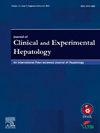Evaluation of Acute Kidney Injury (AKI) Biomarkers FABP1, NGAL, Cystatin C and IL-18 in an Indian Cohort of Hospitalized Acute-on-chronic Liver Failure (ACLF) Patients
IF 3.3
Q2 GASTROENTEROLOGY & HEPATOLOGY
Journal of Clinical and Experimental Hepatology
Pub Date : 2024-12-23
DOI:10.1016/j.jceh.2024.102491
引用次数: 0
Abstract
Background/Aims
Acute-on-chronic liver failure (ACLF) is a complication of cirrhosis associated with systemic inflammation and organ dysfunction. In ACLF, the development of acute kidney injury (AKI) is associated with poor outcomes. FABP1, NGAL, Cys C and IL-18 have been shown to correlate with ACLF severity and mortality. Hence, our study aimed to evaluate the association of these biomarkers with organ dysfunctions, particularly AKI, in an Indian ACLF patient cohort.
Methods
151 study participants including ACLF (n = 91; with AKI n = 63, no-AKI n = 28), non-liver AKI (n = 30) and healthy controls (n = 30) were recruited. Serum ELISA was performed for biomarker estimation. Data interpolation and graphical representation were performed using GraphPad Prism and statistical analyses performed using STATA 14.0.
Results
FABP1 and Cys C levels were higher in ACLF-AKI patients compared to ACLF no-AKI (P-value ≤ 0.0005). Serum Cys C levels were significantly increased in non-liver AKI compared to ACLF-AKI (P-value ≤ 0.001). AUROC analysis showed better performance of Cys C (AUC 0.79; 95% CI (0.68–0.89)) compared to serum creatinine (AUC 0.71; 95% CI (0.61–0.82)) in discriminating AKI and no-AKI. Correlation analysis revealed positive correlations of FABP1 with creatinine and urea, Cys C with creatinine, urea and OF-Kidney, NGAL, and IL-18 with general markers of organ dysfunction. Plasma MTs) measured in a subset of ACLF patients were elevated in progression-to-AKI.
Conclusion
Our study showed that in an Indian population of ACLF patients with a high short-term mortality, serum Cys C and FABP1 were elevated in ACLF-AKI, however did not have predictive potential for ACLF-AKI. Cys C levels were significantly higher in non-liver AKI patients vs. ACLF-AKI and correlated with markers of kidney dysfunction whereas NGAL and IL-18 represented higher inflammation and total organ dysfunction. Hence, we conclude that these biomarkers were elevated in ACLF-AKI but did not have predictive potential for AKI in ACLF.

急性肾损伤(AKI)生物标志物FABP1、NGAL、胱抑素C和IL-18在印度住院急性慢性肝衰竭(ACLF)患者中的评价
慢性急性肝功能衰竭(ACLF)是肝硬化与全身炎症和器官功能障碍相关的并发症。在ACLF中,急性肾损伤(AKI)的发展与不良预后相关。FABP1、NGAL、Cys C和IL-18已被证明与ACLF严重程度和死亡率相关。因此,我们的研究旨在评估这些生物标志物与器官功能障碍的关系,特别是在印度ACLF患者队列中AKI。方法纳入ACLF (n = 91;有AKI者63例,无AKI者28例),非肝性AKI者30例,健康对照者30例。采用血清酶联免疫吸附试验(ELISA)测定生物标志物。使用GraphPad Prism进行数据插值和图形表示,使用STATA 14.0进行统计分析。结果ACLF- aki患者fabp1和Cys C水平高于ACLF- aki患者(p值≤0.0005)。与ACLF-AKI相比,非肝脏AKI患者血清Cys - C水平显著升高(p值≤0.001)。AUROC分析显示,Cys C的性能较好(AUC为0.79;95% CI(0.68-0.89))与血清肌酐(AUC 0.71;95% CI(0.61-0.82))用于区分AKI和非AKI。相关分析显示,FABP1与肌酐和尿素呈正相关,Cys C与肌酐、尿素和of - kidney呈正相关,NGAL和IL-18与器官功能障碍的一般标志物呈正相关。一部分ACLF患者的血浆MTs在进展为aki时升高。我们的研究表明,在短期死亡率较高的印度ACLF患者人群中,血清Cys C和FABP1在ACLF- aki中升高,但对ACLF- aki没有预测潜力。与ACLF-AKI相比,非肝脏AKI患者的Cys - C水平显著高于ACLF-AKI,且与肾功能障碍标志物相关,而NGAL和IL-18则代表更高的炎症和全器官功能障碍。因此,我们得出结论,这些生物标志物在ACLF-AKI中升高,但在ACLF-AKI中没有预测AKI的潜力。
本文章由计算机程序翻译,如有差异,请以英文原文为准。
求助全文
约1分钟内获得全文
求助全文
来源期刊

Journal of Clinical and Experimental Hepatology
GASTROENTEROLOGY & HEPATOLOGY-
CiteScore
4.90
自引率
16.70%
发文量
537
审稿时长
64 days
 求助内容:
求助内容: 应助结果提醒方式:
应助结果提醒方式:


